Overview
Design Resources
Design & Integration File
- Schematic
- PCB Layout
- BOM
- Fab Package
- Software Files
Evaluation Hardware
Part Numbers with "Z" indicate RoHS Compliance. Boards checked are needed to evaluate this circuit.
- MAXREFDES174# ($85.16) EV Kit
Description
The MAXREFDES174# is a complete, high-accuracy, IO-Link® distance sensor reference design that provides accurate measurements for distances up to 4m. Built in an industrial form factor, the reference design makes use of a commercially available time-of-flight (ToF) laser-ranging sensor.
In this design, a Renesas RL78 (R5F10E8EALA) microcontroller interfaces between the distance sensor and the MAX22513 IO-Link device transceiver. The MAX22513 features an internal high-efficiency DC-DC buck regulator, two internal LDOs, and integrated surge protection for robust communications in a very small PCB area without requiring external protection components, such as TVS diodes. The MAX22513 is in a 28-pin TQFN package, allowing the MAXREFDES174# to have a tiny footprint of just 1.2in (3cm) in length. The design is reverse-polarity protected using the integrated active reverse-polarity protection of the MAX22513. The internal DC-DC buck regulator significantly reduces power dissipation, and the two integrated LDO regulators in the MAX22513 generate 3.3V and 5V, which reduces the number of required external components and saves space. The MAX22513 also features low on-resistance drivers (C/Q and DO/DI) to further reduce power dissipation, allowing this reference design to consume minimal power with very low thermal dissipation.
This sensor utilizes the IQ2 Development® IO-Link device stack to communicate to any IO-Link version 1.1-compliant master. The board contains a male M12 connector for connecting to a compliant IO-Link master using a standard M12 cable. Connecting the MAXREFDES174# to a USB IO-link master, such as the MAXREFDES145#, with the associated software allows for easy evaluation.
Design files, firmware, and software are available on the Design Resources tab. The board is also available for purchase.
Features & Benefits
- IEC 61131-9 Compliant
- IQ2 Development IO-Link Stack
- IO-Link Version 1.1 Compliant
- Measures Distances Up to 4m
Parts Used
Details Section
Introduction
Advanced factory automation solutions (i.e., Industry 4.0) require an increasing number of smart sensors, which are typically controlled using IO-Link point-to-point serial communication between the sensor and controller (master). As a leading provider of IO-Link sensor transceiver and master transceiver ICs, Analog also provides complete reference design solutions to help our customers improve their time to market. These proven designs cover all of the hardware and software requirements needed for compliance with the IO-Link standard. The complete reference design is provided on a 30mm x 7.5mm printed circuit board (PCB).
Analog Devices and IQ2 Development collaborated to design the MAXREFDES174# reference design that is compliant with the IO-Link version 1.1/1.0 standard. The MAXREFDES174# design consists of an industry-standard MAX22513 IO-Link device transceiver, a Renesas RL78 low-power microcontroller that uses the IQ2 Development IO-Link device stack, and a commercially available VL53L1 distance sensor.
Detailed Description of Hardware
The MAXREFDES174# IO-Link distance sensor consumes minimal power, space, and cost, making it a complete solution for distance and proximity sensing in many industrial control and automation applications.
The MAX22513 IO-Link device transceiver is compliant with the IO-Link version 1.1/1.0 physical layer specification. It integrates the high-voltage functions commonly found in industrial sensors, including drivers, a high-efficiency DC-DC buck regulator, and two linear regulators all in a tiny 4.1mm x 2.1mm WLP. The MAX22513 features extensive integrated protection to ensure robust communication in harsh industrial environments. All four I/O pins (V24, C/Q, DO/DI, and GND) are reverse-voltage and short-circuit protected and feature integrated ±1kV/500Ω surge protection. This enables a very small PCB area with no required external protection components (e.g., TVS diodes). The low on-resistance drivers (C/Q and DO/DI) further reduce power dissipation so that this reference design consumes minimal power with very low thermal dissipation. Operation is specified for normal 24V supply voltages up to 36V. Transient protection is simplified due to high voltage tolerance (i.e., 65V absolute maximum rating for the I/O pins without the integrated TVS diodes) in addition to the integrated surge protection.
The DC-DC buck regulator significantly reduces system power dissipation by dropping to a lower voltage from 24V more efficiently than a linear regulator. The two integrated LDO regulators in the MAX22513 generate 3.3V and 5V, reducing the number of additional external components and the required space. The DC-DC regulator can supply up to a 300mA load current.
The MAX22513 features a flexible control interface through either an SPI or I2C interface. In this design, we use I2C to reduce the number of pins required by the microcontroller. I2C also allows both the MAX22513 and the sensor IC to be on the same bus. The I2C (or SPI) interface provides extensive diagnostics for the MAX22513, and a 3-wire UART interface is provided for IO-Link operation.
The VL53L1X is a ToF laser-ranging sensor that provides accurate distance ranging up to 4m (400cm). The ranging sensor is programmed with firmware and is controlled by a simple I2C interface with a preprogrammed device address of 0x52. The module does not have a cover for the receiving lens, so care should be taken to keep the lens clean. Distance measurement performance is impacted when the lens is dirty. The VL53L1X is in a small, 4.9mm x 2.5mm x 1.6mm, module and operates over the -20°C to +85°C temperature range. This sensor limits the reference design operating temperature range, as the MAX22513 IO-Link transceiver can operate over the -40°C to +125°C temperature range.
The MAXREFDES174# does not require external protection devices such as varistors or TVS diodes due to the integrated surge protection in the MAX22513 at the IO-Link interface. This reference design meets both IEC 61000-4-2 for electrostatic discharge (ESD) up to ±4kV and IEC 61000-4-4 for electrical fast transient (EFT) ±4kV standards. It is designed to meet a surge capability (2A at t = 1.2/50μs) up to ±1.0kV.
To keep costs low, the MAXREFDES174# uses an industry-standard M12 connector, which allows a 4-wire cable to be used.
The MAXREFDES174# consumes less than 9mA (typ). A green LED indicates the 3.3V alive signal, and a yellow LED blinks for each distance sensor reading. A red LED turns on to indicate when a fault occurs.
Detailed Description of Software
As seen in Figure 2, the MAXREFDES174# was verified using the iqLink® IO-Link Master, which features the MAX14819 IO-Link master transceiver, and the IODD interpreter tool iqPDCT®.

Figure 2. MAXREFDES174# and the iqLink Master from IQ2 Development.
Download the IODD file (*.xml) located in the Design Resources tab and see the Quick Start Guide for step-by-step instructions on how to use the software. Figure 3 shows a screenshot of the IQ2 Development iqPDCT IO-Link device tool communicating with the master and sensor.
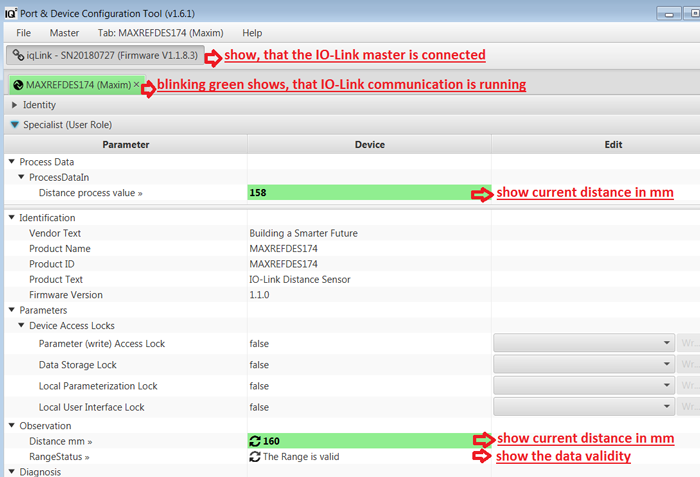
Figure 3. The iqPDCT IO-Link device tool with the MAXREFDES174#.
Detailed Description of Firmware
The MAXREFDES174# ships preprogrammed as a working IO-Link distance sensor ready to connect to an IO-Link master. The firmware targets a RL78 microcontroller and follows the simple flowchart shown in Figure 4. The firmware utilizes the IQ2 Development IO-Link device stack. After hot plug-in, the MAXREFDES174# waits for a wake-up signal from the IO-Link master. Once the wake-up signal is received, the MAXREFDES174# synchronizes to the IO-Link master using the 230.4kbps (COM3) baud rate, and communication parameters are exchanged. The IO-Link Master then starts a cyclic data exchange by requesting the sensor process data. If the sensor is removed, the IO-Link master detects a missing sensor.
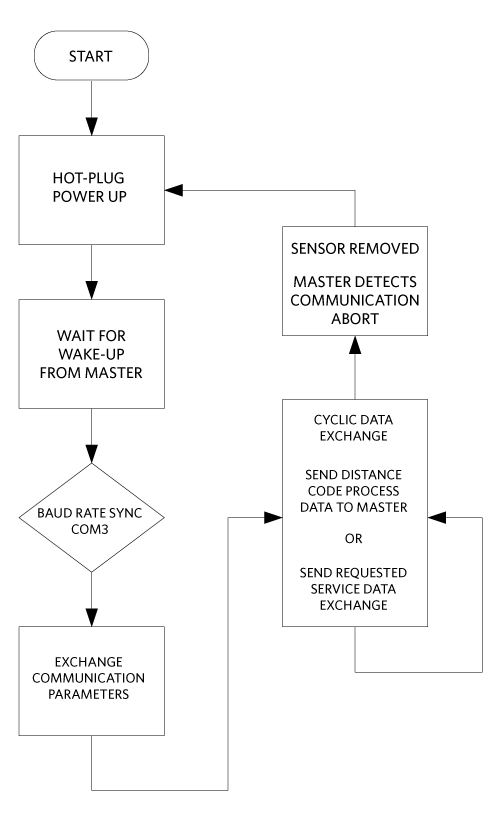
Figure 4. MAXREFDES174# firmware flowchart.
The IQ2 Development iqPDCT IO-Link Device Tool software is Windows®-compatible and features IODD file import capability, connects to a PC through USB, and is available to download from the IQ2 Development website when an IQ2 Development master is purchased.
The IQ2 Development IO-Link Device Tool software is shown in Figure 3, and a complete guide is also downloadable from IQ2 Development.
Source code for the MAXREFDES174# is not available. The IQ2 Development IO-Link stack ships preprogrammed inside the MAXREFDES174# hardware with a perpetual license.
The IQ2 Development contact information is as follows:
IQ2 Development GmbH & Co. KG
Carl-Benz-Strasse 3
72585 Riederich
Germany
Phone: +49 7127 5706100
Fax: +49 7127 5706102
E-Mail: info@IQ2-development.de
Internet: www.IQ2-development.de
EMC Testing
EMC Requirements Defined by IO-Link Interface and System Specification Version 1.1.2
| Phenomena | Test Level | Performance Criterion | Constraints |
| Electrostatic discharges (ESD) IEC 61000-4-2 |
Air discharge: ±8kV Contact discharge: ±4kV |
B | See G.1.4. a) |
| Radio-frequency electromagnetic field. Amplitude modulated. IEC 61000-4-3 |
80MHz to 1000MHz 10V/m 1400MHz to 2000MHz 3V/m 2000MHz to 2700MHz 1V/m |
A | See G.1.4. a) and G.1.4, b) |
| Fast transients (Burst) IEC 61000-4-4 |
±1kV | A | 5kHz only. The number of M-sequencers in Table G.1 shall be increased by a factor of 20 due to the burst/cycle ratio 15ms/300ms. See G.1.4,c) |
| ±2kV | B | ||
| Surge IEC 61000-4-5 |
Not required for an SDCI link (SDCI link is limited to 20 m) |
— | |
| Radio-frequency common mode IEC 61000-4-6 |
0.15MHz to 80MHz 10V EMF |
A | See G.1.4. b) and G.1.4, d) |
| Voltage dips and interruptions IEC 61000-4-11 |
Not required for an SDCI link | — | |
The IO-Link EMC requirements define two performance criteria. Criterion A requires no more than six detected M-sequence errors and no interruption of communication. Criterion B does not allow a change in the stored data or of the actual operating state (e.g., permanent loss of communication).
The general rules for the test configuration of a device (such as the MAXREFDES174#) are as follows:
- SDCI cable shall be unshielded and 20m long, coiled, and placed 10cm (4”) above the ground plane
- The devices shall be placed 10cm (4”) above the ground plane
For the EFT test setup according to IEC 61000-4-4, see Figure 6
The MAXREFDES174# was tested in a Analog lab for the common industrial compliance standards, and the test methodology and results are presented. Although the IO-Link Interface and System Specification does not require surge testing, Analog did this test in addition to the ESD and EFT tests.
Equipment Used
- MAXREFDES174# IO-Link Sensor
- MAXREFDES145# 8-Port IO-Link Master
- 20m M12 Cable
- Haefely®Technology ECompact4 EFT/Surge Generator
- Teseq®CDN 117 Signal Line Coupling Network
- Teseq CDN 3425 EFT Data Line Coupling Clamp
- Teseg NSG438 ESD Generator
- 24V DC Power Supply
Surge Testing
The MAXREFDES174# module was tested to withstand up to ±1.0kV of 1.2/50µs IEC 61000-4-5 surge with a total source impedance of 500Ω. Surge testing was performed using the MAXREFDES145# IO-Link master, and 10 surge pulses were applied for each test as shown in Table 2. The MAXREFDES174# was not damaged by the tests.
The performed surge tests are defined as follows:
- L+ to GND: Communicating with the master, the module continued to execute code and transfer data, and the MAX22513 registers were not corrupted.
- CQ to GND: Communicating with the master, the module continued to execute code and transfer data, and the MAX22513 registers were not corrupted.
- L+ to CQ: Communicating with the master, the module continued to execute code and transfer data, and the MAX22513 registers were not corrupted.
| Test Condition | L+ to GND | CQ to GND | L+ to CQ |
| +1kV | Pass | Pass | Pass |
| -1kV | Pass | Pass | Pass |
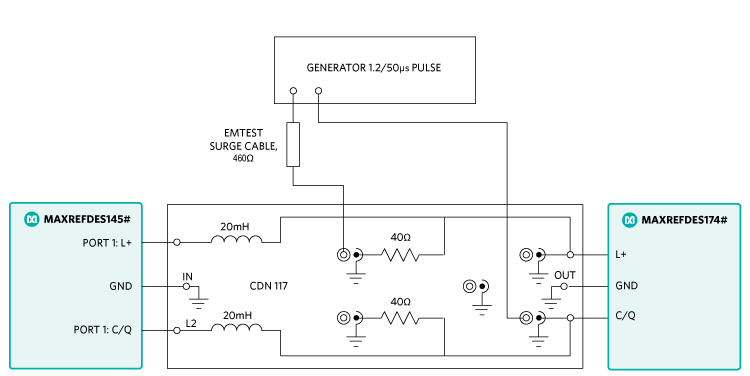
Figure 5. Surge testing setup.
EFT/Burst Testing
Using a 20m IO-Link cable with standard M12 connectors, the MAXREFDES174# was tested to withstand electrical fast transient (EFT)/bursts up to ±4kV according to IEC 61000-4-4. EFT. Testing was performed using the MAXREFDES145# IO-Link master, and EFT pulses were applied for one minute for each test, as shown in Table 3.
| Test Condition | 5kHz/15ms | 100kHz/0.75ms |
| +4kV | Pass | Pass |
| -4kV | Pass | Pass |
Repetition rates of 5kHz and 100kHz were tested, along with burst lengths of 15ms and 0.75ms. The MAXREFDES174# was not damaged by the test, and the MAX22513 registers were not corrupted.

Figure 6. Test setup for fast transients (device).
Figure 7 shows the test setup for the EFT and surge tests according to IEC 61000-4-4 and IEC 61000-4-5.
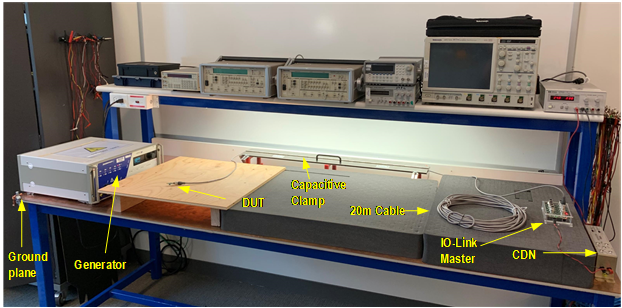
Figure 7. EFT/burst testing.
Due to test equipment limitations, we were unable to count M-sequence errors. To validate if the MCU on the MAXREFDES174# was susceptible to EFT, it was programmed to generate square wave outputs to toggle the C/Q and DO pins. On the square-wave, disturbances that imply communication errors were not detected (i.e., the high and low levels were always within their range).
It was clear that the MAX22513 did not go through a reset because the reset settings of the MAX22513 could have disabled the CQ output driver. Additionally the microcontroller firmware was set up to toggle C/Q very fast every time the microcontroller was reset (Figure 8). This clearly indicates if a reset occurred on the microcontroller, which also causes the MAX22513 registers to be re-initialized by the microcontroller. The pass/fail test criteria were that the high/low levels were not disturbed and no fast toggling was observed.
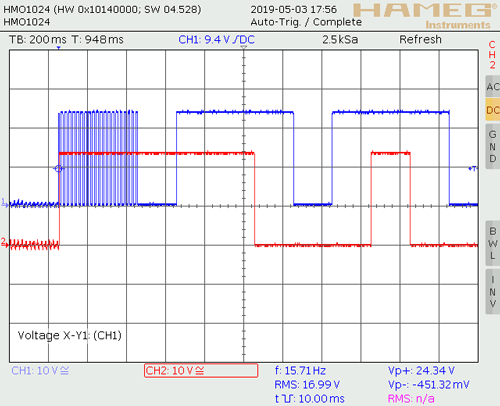
Figure 8. C/Q and DO toggling with MCU/Reset.
ESD Testing
The MAXREFDES174# was tested to withstand electrostatic discharge (ESD) for contact and air gap discharge up to ±4kV according to IEC 61000-4-2. ESD testing was performed on the MAXREFDES174# M12 connector pins, after the test operation was verified using the MAXREFDES145# IO-Link master to transfer data, as shown in Table 4. The MAXREFDES174# was not damaged by any ESD tests and continued to operate normally.
| Test Condition | L+ to GND | CQto GND |
| +4kV Contact Discharge | Pass | Pass |
| -4kV Contact Discharge | Pass | Pass |
| +4kV Airgap Discharge | Pass | Pass |
| -4kV Airgap Discharge | Pass | Pass |
Note that the IO-Link Interface and System Specification Version 1.1.2 requires ESD testing with a 20m cable attached, and the ESD strike is applied to the sensor casing. Because this reference design is only a PCB with no metallic casing, the ESD strikes were applied to the male M12 connector pins. Analog expects this design to meet the levels specified in Table G.2 when testing with a casing and cable (Table 1).
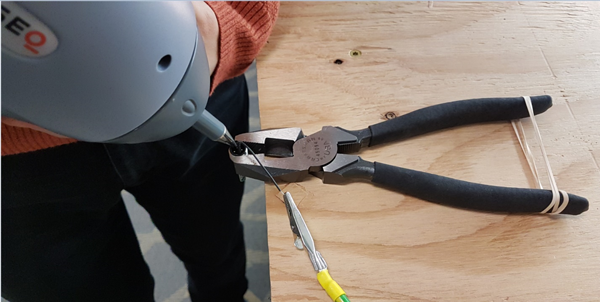
Figure 9. ESD testing.
Analog Reference Design Use Restrictions and Warnings
The MAXREFDES174# is designed and tested to meet IO-Link operation and harsh industrial environments covered by IEC 61000-4-x standards for transient immunity. This board and associated software are designed to be used to evaluate the performance of the MAX22513 but are not intended to be deployed as-is into an end-product in a factory automation system.
The MAXREFDES174# is not for use in functional safety and/or safety critical systems.
Quick Start Guide
To test the MAXREFDES174# sensor, connect it to a port of an IO-Link master. In the following example, an iqLink IO-Link master is used, but any IO-Link compliant master and associated IO-Link device GUI should work.
Required Equipment
Supplied by Analog:
- MAXREFDES174#
Note: Download files from the Design Resources tab.
User Supplied:
- IO-Link master (i.e., the iqLink) with an AC-to-DC 24V power adapter
- iqPDCT IO-Link Device Tool Software
- One IO-Link cable
- Windows 7, Windows 8, or Windows 10 PC with a USB port
Procedure
Master Setup Procedure
- Connect the MAXREFDES174# sensor to the IO-Link Master with an IO-Link M12 cable.
- Connect the IO-Link Master to the PC with a USB cable.
- Download and install the latest iqPDCT software from the IQ2 Development website (https://www.iq2-development.de).
- Download the IODD file for the MAXREFDES174# from the Design Resources tab or from the IQ2 Development website (https://www.iq2-development.de).
- The MAXREFDES174# comes programmed with firmware.
- Connect the female end of the IO-Link cable to the MAXREFDES174#.
- Connect the male end of the IO-Link cable to one of the ports on the IO-Link master.
- Open the iqPDCT software.
- Import the IODD file for the MAXREFDES174#.
- Press the Connect button.
- If communication is established correctly, the iqPDCT software shows the IO-Link master connection, the device tab blinks green, and the process data shows the current temperature, as shown in Figure 10.
- Apply a trigger to the sensor to continuously update the data as distance in millimeters.
Sensor Testing Procedure
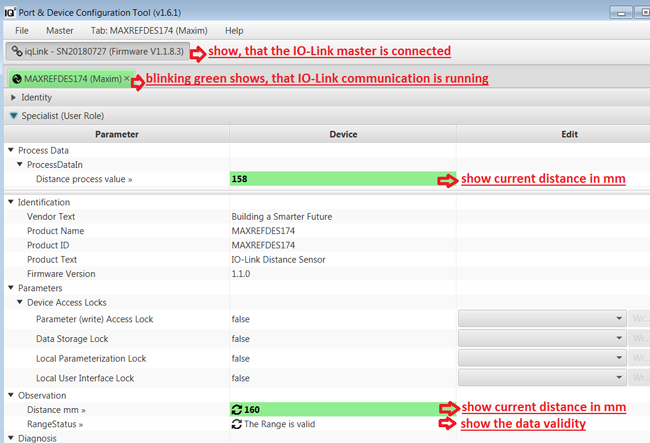
Figure 10. MAXREFDES174# sensor found.
Documentation & Resources
-
MAXREFDES174 Design Files6/11/2021ZIP2 M
Support & Training
Search our knowledge base for answers to your technical questions. Our dedicated team of Applications Engineers are also available to answer your technical questions.





